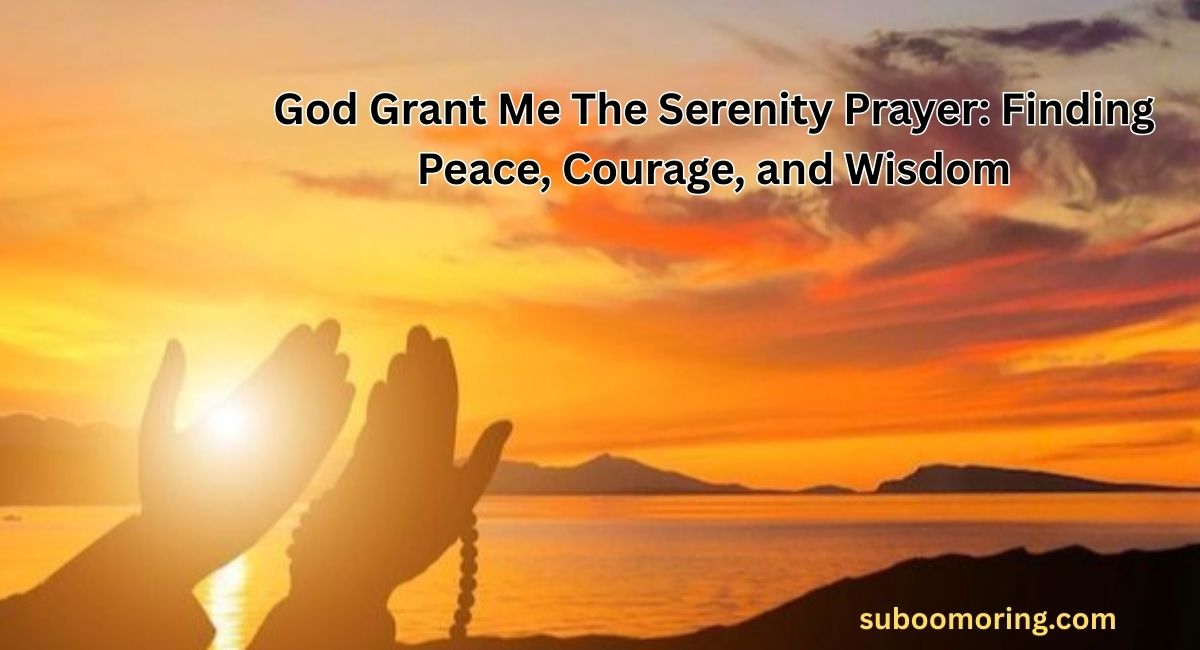Introduction to the Serenity Prayer
sThe simple plea “God grant me the serenity to accept the things I cannot change…” carries a spiritual anchor in troubled times. Countless Americans lean on this prayer for serenity to receive peace of mind, rest in faith in God, and learn how to keep calm amid life’s storms.
This powerful daily prayer for peace resonates across cultures. It shows how letting go and trusting God can bring mental and emotional peace even when circumstances feel overwhelming.
The Full Serenity Prayer (Original & Extended Versions)
The familiar version says, “God grant me the serenity…”, followed by courage and wisdom. A longer version breathes deeper into contentment, “living one day at a time…” Sadly, not everyone knows this extended form, though it beautifully expands the meaning.
Here’s a simple table to compare:
| Version | Text Snippet |
| Short | “God grant me the serenity…” |
| Extended | “Living one day at a time, enjoying one moment at a time…” |
Who Wrote the Serenity Prayer?
Most credit Reinhold Niebuhr, a noted American theologian from the 1930s. Journals, essays, and memoirs all point back to him as the source. His daughter Elisabeth helped seal that connection in her book about the prayer’s history
Yet research shows earlier versions circulated by 1936, leading scholars to wonder if Niebuhr unconsciously shaped them. Still, the strongest evidence supports his authorship
History of the Serenity Prayer
The prayer traveled across the United States in the 1940s through churches, newspapers, and the YWCA. Soldiers tucked it in their Bibles during World War II, searching for calm amid chaos.
Alcoholics Anonymous found it in a newspaper around 1941 and wove it into nearly every meeting. Since then, it’s grown into a bedrock of healing prayers in the recovery community.
What Does the Serenity Prayer Mean?
It invites us to want serenity—true inner peace—when things feel out of control. Then we ask for “courage to change the things we can”, reminding us to be active. The closing “wisdom to know the difference” teaches clarity and discernment.
These three lines blend calm, boldness, and understanding into one powerful prayer for wisdom and action. It’s an enduring call to overcoming fear through prayer.
The Main Themes of the Prayer
At its heart, the prayer is about acceptance and faith, about being steady when life rattles our peace. It rewards us with peace of mind rather than restlessness.
It also nurtures courage—not to push every rock—but to bravely pursue what truly matters. And it leans on divine wisdom to guide our decisions.
How the Serenity Prayer Helps in Daily Life
When stress grips the mind, this prayer becomes a moment’s pause, a mini retreat for the soul. It brings Christ‑centered calm into noisy chaos.
By reminding us to let go and trust God, it helps us break cycles of worry. In practice, it restores hope and aligns our day with God’s calm plan.
How to Accept Things You Cannot Change
You start by quietly repeating “God is my refuge and strength”, and letting the words sink deep. When worry pops up, you draw strength from that truth.
This simple practice fosters emotional healing prayer, allowing you to rest—yes, even in the middle of turmoil.
Using the Serenity Prayer in Difficult Times
When life lands a blow, whispering “Finding peace in the storm” can stop the panic. You anchor yourself in “peace that surpasses understanding”, even amid chaos.
You may not understand now, but you trust that your turbulent heart rests under God’s gentle care.
Serenity and Recovery: Why It Matters
In recovery, every morning can feel like a battle. Holding the lines “serenity, courage, wisdom”, helps regain footing. The prayer laces faith and healing.
It becomes a quiet anthem, helping people remember they’re not alone and that change is possible—one decision at a time.
The Serenity Prayer in Twelve‑Step Recovery Programs
AA, NA, and other programs center around this prayer. It opens their meetings and grounds the community in shared spiritual guidance and hope.
Together, they weave a web of support where everyone learns to live with trust, courage, and clarity—supported by a simple but powerful plea.
Serenity Prayer & Mental Health
Therapists now use it alongside Cognitive Behavioral Therapy. It reminds people that control lies not in fixing everything, but in focusing on what we can change.
That truth becomes a gentle tool for faith-based anxiety relief, helping push back panic and rest in clarity.
Is There a Non-Religious Version of the Serenity Prayer?
Yes, many versions drop overtly religious words and keep the heart intact. They use words like “calm” or “grace” instead, offering a more universal appeal.
People seeking mental and emotional peace without faith labels still find it centering and steady.
Who Uses the Serenity Prayer Today?
From church youth groups to corporate offices, from grief groups to quiet evenings at home—this prayer crosses generational and cultural boundaries.
Anyone longing for spiritual guidance, peace of mind, or simply a moment of calm may lean on it.
The Serenity Prayer and the Bible
Many wonder if the Serenity Prayer comes directly from the Bible. While the prayer itself isn’t a direct biblical quote, its themes deeply reflect biblical teachings. Passages like Philippians 4:6–7 speak about finding peace that surpasses understanding, which aligns closely with the prayer’s message of acceptance and faith. Romans 12:2 encourages believers to seek transformation through renewing their minds, echoing the prayer’s call for divine wisdom.
The prayer embodies key biblical principles such as trusting God’s plan, seeking courage in trials, and asking for spiritual guidance. It mirrors the Bible’s emphasis on letting go and trusting God, especially during difficult moments. So, while not scriptural in origin, the Serenity Prayer beautifully captures the essence of Christian prayer for strength and faith-based anxiety relief, making it a powerful spiritual tool for many believers.
Related Bible Verses for Serenity and Wisdom
Here’s a small table of verses to meditate on:
| Verse | Theme |
| Romans 6:3–14 | New life and serenity |
| Titus 3:1–15 | Kindness through trials |
These Scriptures deepen the prayer’s meaning and invite divine wisdom into our reflection.
Serenity Prayer in Different Languages
In Spanish, it begins, “Dios concédeme serenidad…”. French, German, and more join in. In each language, the prayer adapts beautifully to cultural soul.
It proves that peace, courage, and wisdom are universal desires.
Common Questions About the Serenity Prayer
Is it only for AA? No. Anyone can say it, whether during crises or quiet moments. It’s more prayer than mantra, though it works like one with its steady rhythm.
If you’re not Christian, you can still adapt it. Many do, and it still works powerfully, reminding us: we’re human, and sometimes we need help to simply breathe.
Printable Serenity Prayer & Resources
Having a printable Serenity Prayer handy can make a big difference in your daily spiritual practice. Whether you want to keep it by your bedside, on your desk, or in your journal, having a clear and beautiful copy helps you remember to say this daily prayer for peace. Many websites offer free PDFs and images of the prayer, which you can easily download and print.
Some printable versions come with added features like inspirational artwork, bookmarks, or framed designs. These can serve as constant reminders of God’s sovereignty and the power of letting go and trusting God. Using these resources helps bring mental and emotional peace into your life, making it easier to turn to the prayer during hard times or moments of doubt. Keep one close and watch how your faith in God grows stronger with every recitation.
Five‑Minute Meditation on the Serenity Prayer
Close your eyes, breathe, and say “Holy Spirit, guide me.” Let the prayer’s simple rhythm settle your mind. You don’t need more than a few lines and a breath to remember you’re held.
In this short pause, peace that surpasses understanding begins to bloom inside you.
How to Use the Serenity Prayer Every Day
Start your morning by quietly saying, “Living one day at a time with God’s grace.” When anxiety hits, whisper, “Trust in God’s perfect will.” Let it drift onto your journal later.
Using it often transforms these words into a calm companion that walks with you through each day.
Related Prayers
Alongside the Serenity Prayer, saying a prayer for peace of mind or a prayer of gratitude and acceptance can bring deep comfort. These short, heartfelt prayers help you stay connected to God and rooted in hope, even when life feels heavy. They are gentle reminders that you are never alone.
A simple prayer for strength and courage or a moment of quiet thanksgiving can calm your spirit and fill your heart with peace. These daily prayers guide your thoughts, making it easier to focus on what matters. They become part of a healing rhythm—a way to speak with God when words are hard to find.
Over time, this rhythm becomes powerful. It helps emotional healing, supports faith during trials, and brings a sense of stillness to your day. These prayers don’t need to be long or fancy. Just honest. Just real. They build your spiritual anchor in troubled times and help you grow stronger in faith.
Inspirational Quotes Related to Serenity and Acceptance
Quotes about serenity and acceptance give us comfort when life feels uncertain. They remind us to slow down, breathe, and let go. One well-known quote from Reinhold Niebuhr says, “God grant me the serenity to accept the things I cannot change…” This line is more than just words—it’s a powerful prayer for serenity that helps people through pain, worry, and fear.
Another quote many people love is from Psalm 46:1: “God is my refuge and strength.” This reminds us that trusting God’s plan brings safety during hard times. Some people also say, “Let go and let God,” which means stop trying to control everything and allow God’s sovereignty to lead the way. These words speak deeply to those going through grief, addiction, or life changes. They help us practice acceptance and faith, and offer faith-based anxiety relief.
Quotes like “Finding peace in the storm” or “Peace that surpasses understanding” are great for daily reflection. They help us calm our thoughts and feel closer to God. Even short reminders such as “Holy Spirit, guide me” or “Surrendering control to God” can offer strength in moments of fear.
Whether from the Bible, famous thinkers, or modern writers, these quotes inspire healing and hope. They help us connect to emotional healing prayer and trust that peace can come even in difficult times. When repeated often, they become a source of calm, courage, and clarity in everyday life.
Final Thoughts: Why the Serenity Prayer Still Matters
The God Grant Me The Serenity Prayer endures because we still wrestle with the same questions: how to accept, how to act, and how to see clearly. Its words remain vibrant, alive, and ready to guide.
Lean into it. Let it walk with you through storms and calm. Let it be your voice when silence feels too loud.
Welcome! I’m a passionate digital creator with over 5 years of experience in delivering top-notch online services. I specialize in:
Social Media Services: Boost your presence on platforms like YouTube, TikTok, Instagram, and Facebook with tailored strategies.
Content Writing: Need high-quality articles or blog posts? I provide original, engaging, and SEO-friendly content.
Graphic Design: I design custom logos that stand out and reflect your brand identity.
Document Conversion: Fast and accurate conversion of documents into formats like JPG, PNG, PDF, and more.
Ads Management: I run and manage effective online advertising campaigns that drive real results.
I’m dedicated to helping individuals and businesses grow online through creative and reliable digital solutions. Let’s work together and bring your vision to life!

